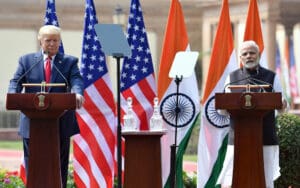
India’s exports to the United States — its largest trading partner — have plunged following the introduction of steep US tariffs on Indian goods, marking one of the sharpest trade shocks in recent years.
According to government data, India’s goods exports to the US dropped 20% in September alone and nearly 40% over the past four months, as Washington’s 50% import duties came fully into effect. The tariffs, introduced on 27 August, include an additional 25% penalty tied to New Delhi’s continued purchases of Russian oil.
“The US has become India’s most severely affected market since the tariff escalation began,” said Ajay Srivastava, co-founder of the Global Trade Research Initiative (GTRI), a Delhi-based think tank.
The new duties have struck hardest at India’s labour-intensive export industries, including textiles, gems and jewellery, engineering goods, and chemicals — all key sectors that employ millions of workers and contribute significantly to foreign exchange earnings.
Shipments to the US have now fallen for four consecutive months, dropping from $8.8 billion (£6.5 billion) in May to $5.5 billion in September, a 37.5% decline, GTRI’s analysis shows.
The slump has also worsened India’s overall trade position. The country’s merchandise trade deficit widened to a 13-month high of $32.15 billion in September, according to official figures, reflecting both weaker exports and resilient import demand.
Some of the fall in US-bound shipments was offset by stronger trade flows with the United Arab Emirates and China, which together absorbed a higher share of India’s recent export growth.
September’s sharp fall represents the first full-month impact of the Trump administration’s tariff package, which aims to penalise India for its energy and trade ties with Russia while demanding greater market access for US agriculture and manufacturing exports.
The White House has argued that India’s continued purchase of discounted Russian crude oil undermines international sanctions designed to pressure Moscow over the war in Ukraine.
Earlier this week, President Donald Trump told reporters that Indian Prime Minister Narendra Modi had agreed to “phase out” imports of Russian oil, part of what he described as “constructive energy cooperation talks.”
However, a spokesperson for India’s Ministry of External Affairs struck a more cautious tone, saying discussions with Washington were “ongoing” and that the US had shown interest in “deepening energy cooperation with India.”
Trade negotiations between the two countries have resumed after months of stalemate, with an Indian delegation currently in Washington seeking to secure concessions that could blunt the tariffs’ impact.
Talks are reportedly aimed at reaching an agreement before the end of November, though both sides acknowledge deep differences remain — particularly over access to India’s agriculture and dairy markets.
For years, Washington has pressed for greater entry into India’s protected farm sector, describing it as a “major untapped market.” New Delhi has resisted, citing food security, rural livelihoods, and the need to safeguard the interests of hundreds of millions of small farmers.
Until recently, the US was India’s largest trading partner, with bilateral trade reaching $190 billion in 2024. Both governments have previously declared an ambition to more than double that figure to $500 billion, but the escalating tariff war has cast doubt over that goal.
Trade experts warn that the new tariffs could dampen investment sentiment and disrupt supply chains at a delicate moment for both economies.
“The timing is unfortunate — global demand is already weakening, and India’s export engines were just beginning to recover,” said Priya Nair, a Mumbai-based trade economist. “The longer these tariffs remain in place, the greater the risk of structural damage to India’s labour-heavy sectors.”
With negotiations under way observers say the coming weeks will determine whether the two governments can turn confrontation into compromise — or whether the world’s two largest democracies are heading for a protracted trade rift.
Read more:
India’s exports to US plunge as Trump’s 50% tariffs take effect






